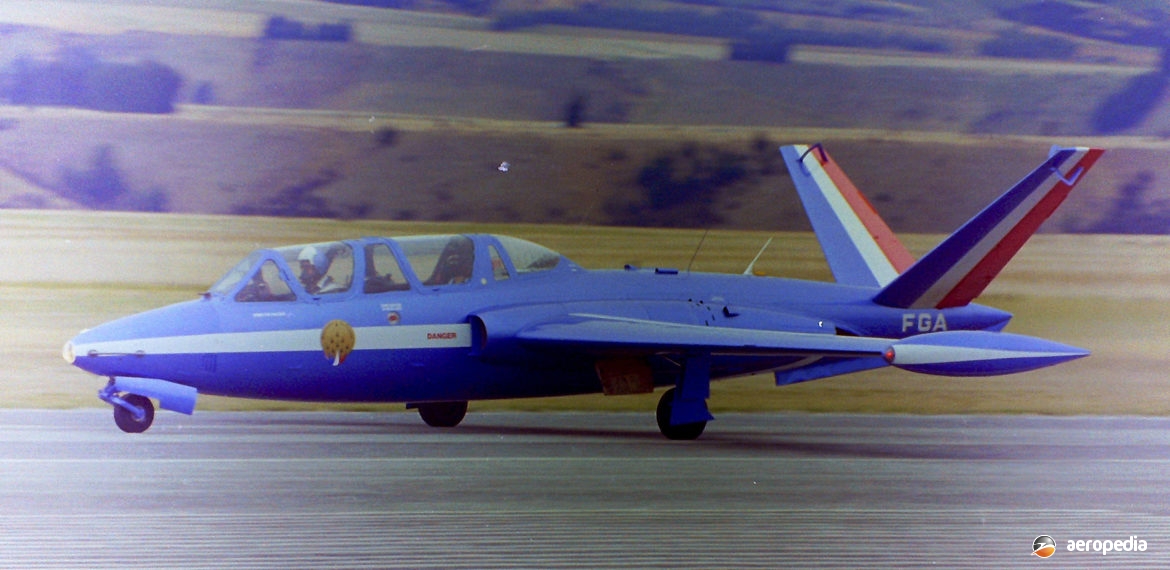Photograph:
Fouga CM-170 Magister ZK-FGA (c/n 216) at Wanaka, New Zealand in 2000 (David C Eyre)
Country of origin:
France
Description:
Two-seat light twin-jet military trainer with light attack capability
Power Plant:
Two 880 lbst Turbomeca Marbore IIA turbojets
Specifications:
- [CM170-1]
- Wingspan: 12.15 m (39 ft 10¼ in)
- Length: 10.06 m (33 ft)
- Height: 2.8 m (9 ft 2 in)
- Wing area: 17.3 m² (186.2 sq ft)
- Max speed at sea level: 650 km/h (403 mph)
- Max speed at 9,000 m (29,525 ft): 713 km/h (443 mph)
- Max rate of climb: 1,020 m/min (3,346 ft/min)
- Service ceiling: 11,000 m (36,070 ft)
- Climb to 9,000 m (29,525 ft): 16 mins
- Take-off run: 550 m (1,800 ft)
- Range at 9,000 m (29,525 ft) with reserve: 925 km (575 miles)
- Endurance at 9,000 m (29,525 ft) with reserve: 1 hr 55 mins
- Empty weight: 2,150 kg (4,750 lb)
- Loaded weight with external tanks: 3,100 kg (6,835 lb)
- Max loaded weight: 3,200 kg (7,055 lb)
Armament:
Provision for two 7.5 mm machine guns in the nose; provision to carry two 50 kg (110 lb) bombs on two underwing hardpoints; four 120 mm rockets or pods containing 37 mm and 68 mm rockets
History:
One of the most successful military turbojet-powered trainers, the Fouga Magister was produced in large numbers, some 437 being completed for the French Air Force. It was licence-built, being produced in Finland by Valmet OY (62), Israel by Israel Aircraft Industries (36), and West Germany by Flugzeug Union Sud (188). Operators included Algeria, Austria, Bangladesh, Belgium, Brazil, Cambodia, Congo, Eire, El Salvador, Finland, France, Guatemala, Lebanon, Morocco, West Germany, Israel, Katanga, Rwanda, Libya, Senegal and Togo.
A contract was signed for three prototypes on 27 June 1951, and the first of these was flown on 23 July 1952, the first of ten pre-production aircraft flying on 7 July 1954. Main variants were the CM-170 Magister; CM-170-2 Super Magister, being an upgraded and refined CM-170; CM-170M first flown on 3 July 1956, this model being for carrier training, fitted with an arrester hook and catapult strap. Deck landing trials were completed on board the Royal Navy aircraft carriers ‘HMS Bulwark’ and ‘HMS Eagle’, the naval production model being the CM-175.
Further variants were the CM-171 which was built as an engine test bed fitted with 2,425 lbst Turbomeca Gabizo turbojets and was first flown on 5 November 1956; the CM-175 Zephyr, of which 32 were built for the French Aeronavale; and the Fouga 90, a modernised descendant with Turbomeca Astafan IIG turbofans, of which only one was built. In addition to use as an Air Force primary trainer, the Magister flew with the Patrouille de l’Ecole de l’Air demonstration team, later known as the Patrouille de France, operating the type from 1957 to September 1980.
The Magister was a mid-wing cantilever monoplane with n NACA 64 series wing section. The wing was of single-spar structure with aluminium-alloy stressed skin. It had hydraulically-operated all-metal slotted high-lift flaps of the area increasing type, and had retractable air brakes in the upper and lower wing surfaces. The fuselage was of oval all-metal semi monocoque stressed skin structure. The tail unit was of the Butterfly type with two tapered surfaces. The undercarriage was built by Messier and was a hydraulically-retractable nosewheel type. Fuel was contained in two fuselage tanks of 255 litres (56 Imp gals) and 475 litres (104 Imp gals) capacity giving a total of 730 litres (160 Imp gals). Two fixed wing-tip tanks containing 125 litres (27.5 Imp gals) each could be attached. Accommodation was provided for two in tandem, the cockpits being pressurised and air-conditioned.
After retirement from military service the type became popular with warbird enthusiasts and examples have been registered in Europe and the United States.
First of the type in this region was imported into New Zealand in 1998. An ex-French Air Force machine, this example was imported from the United States and became ZK-FGA (c/n 216), being painted in the blue and white colour scheme of the Patrouille de France. However, this machine was destroyed in 2004 in an accident.
An example arrived in Australia in 2003 for restoration, this becoming VH-ATG5 (c/n 395 – ex N395F – serial 395 with the French Air Force) for its owner in Perth, WA, being registered on 28 July 2004. It was joined in early 2006 by a further Magister which became VH-FGA4 (c/n 526 – ex N526FM – serial 526 with the French Air Force) and, owned by Wildcrowd Enterprises, has been operated by Fighter Combat International at Jandakot, WA and was registered on 10 February 2006. A third example became VH-FGU (c/n 548 – ex N548FM – serial 548 with the French Air Force) being registered on 7 August 2008.

